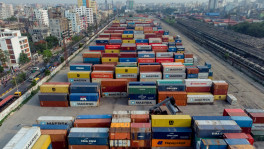Metro Rail Line-6 alone to save Tk3,500cr in travel time, vehicle operation cost yearly
It will take about 40 minutes for a metro train to reach Motijheel from Uttara with a maximum speed of 100 kilometres per hour and stopping at 14 stations in the middle, while it currently takes 208 minutes to cover this 20-km distance by road. From this count, metro rail passengers will save 168 minutes on the entire route.
According to a report by Japan International Cooperation Agency (JICA) – the financier of the metro rail project, with the rate at which the population and human pressure are increasing in Dhaka city, the road transport time on this route will increase to 446 minutes by 2025. But if about five lakh people ride the metro rail every day and the use of private cars and other transports is reduced as per the target, this time will come down to 164 minutes.
As such, the addition of metro rail to Dhaka's public transport is going to benefit the passengers of other transport users as well.

According to Dhaka Mass Transit Company Limited, the owning company of metro rail in the country, if the MRT Line-6 is launched, the financial value of the time that passengers will save every day while travelling is Tk8.38 crore. At the same time, the operational costs of other vehicles will come down by Tk1.18 crore daily.
As such, more than Tk3,489 crore will be saved in these two sectors annually following the opening of the MRT Line-6.
The company also claims that the number of vehicles running on liquid fuel and gas will drop once electric-powered metro trains are launched. This will reduce carbon emissions by more than two lakh tonnes annually.

As vehicular speed was nearing walking speed, the World Bank-supported Strategic Transport Plan (STP) in 2005 recommended the construction of metro rail lines to speed up the traffic movement in the capital.
With the slogan "Moving People Saving Time and Environment", Dhaka Mass Transit Company started implementing the MRT Line-6 project in 2012. The government agency has undertaken a time-bound plan to build a total of six metro rails with a total length of 128.74km by 2030.
Public transportation experts and economists believe that the traffic congestion in Dhaka will reduce significantly if the metro rail is launched. This will improve the business environment and attract more investment, which will leave a positive impact on employment and income.
The Revised Strategic Transport Plan (RSTP) in 2015 says that Dhaka city had a demand of 3.59 crore trips per day in 2009, but this number will increase to 6.55 crore in 2025.
The Uttara-Motijheel Metro Rail line will bear 0.8% of the total trips. As a result, bus ridership will come down to 1.81 crore from 2.06 crore. At the same time, CNG ridership will come down to 60 lakh from 66 lakh. However, the ridership of rickshaws to travel to metro rail stations will increase marginally, as stated in the RSTP.
According to survey findings, if six metro rail lines are launched in Dhaka, more than 50 lakh people will be able to travel by metro trains every day. This figure is 11.52% of total trips projected for 2035.

As a result, the number of bus users will drop to 36.82% from 45.13%, and the number of people travelling on foot will also drop to 25% from 30% during this period.
According to Dhaka Mass Transit Company, the MRT Line-6 project is going to employ 2,000 young engineers and all the lines will require 12,000 engineers. Apart from that, there will be several times more employment in the backward and forward linkage sectors.
Apart from that, even if the use of small vehicles running on fossil fuel is stopped due to metro rail, the wastage will be reduced a lot. Altogether, more than 1% of GDP will be saved through this project.
MAN Siddique, managing director of Dhaka Mass Transit Company Limited, the Uttara Phase-III was a sparsely populated area when the metro rail work started. After the start of the construction of the metro rail infrastructure, the number of schools, colleges as well as various types of business establishments are increasing alongside a growth in the population living in the area, he added.
He said the construction of six metro rails required a huge amount of specialised electrical cables.
Although the product has long been imported from abroad, a local company now wants to invest in this sector, he said, adding that cement and steel production is increasing with a focus on metro rail.
A local company also is looking to invest in elevator manufacturing buoyed by the increasing demand for the product in metro rail projects, he concluded.
 Keep updated, follow The Business Standard's Google news channel
Keep updated, follow The Business Standard's Google news channel
















